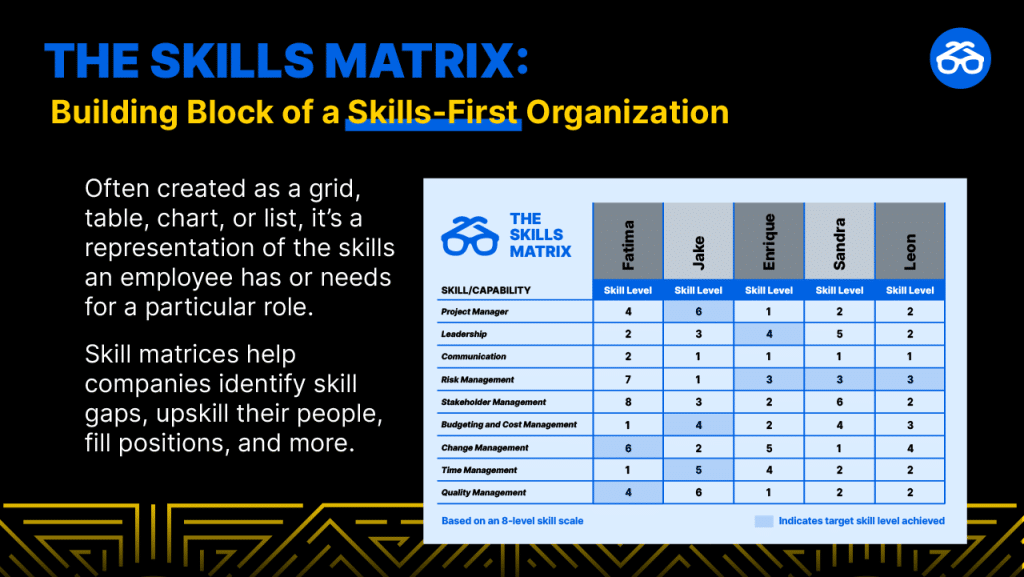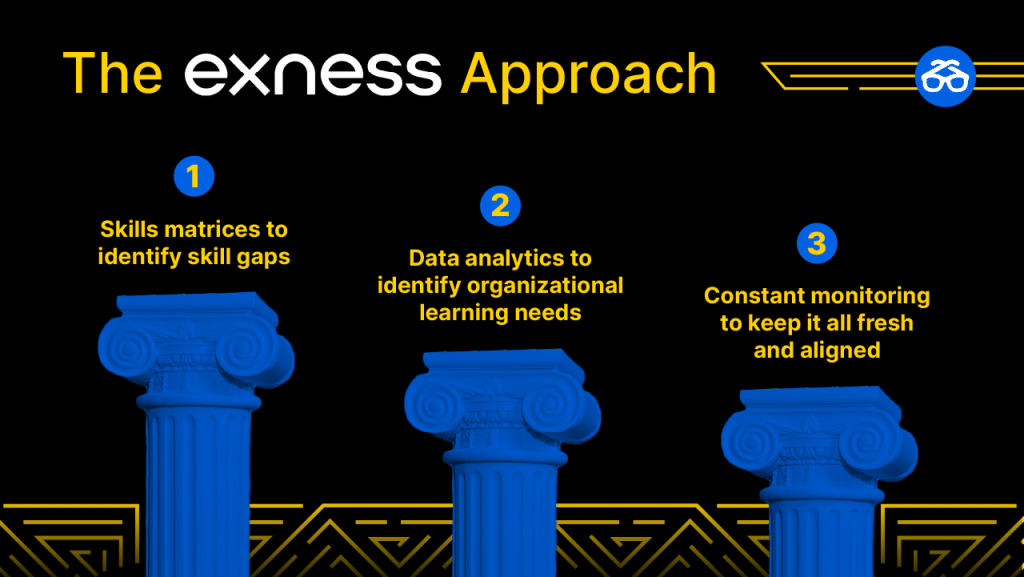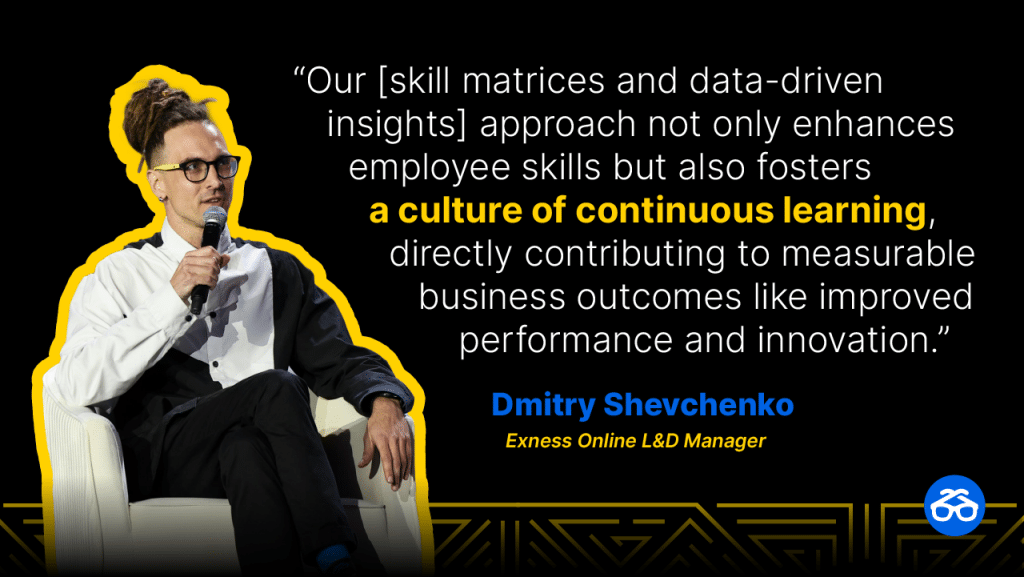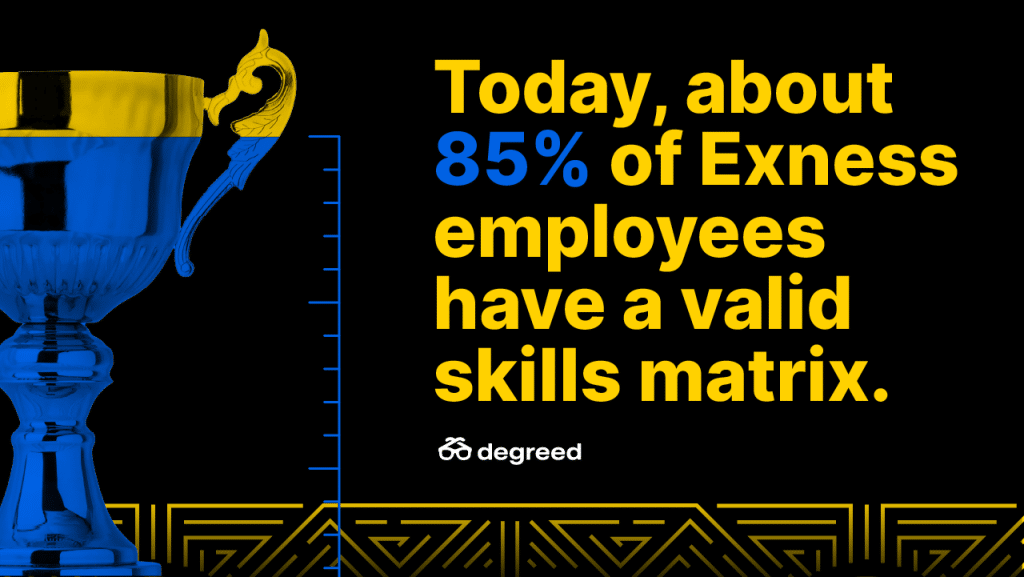The founder of the eLearning Industry recently called skill matrices “one of the most valuable tools you can use to evaluate the skills and competencies of your workforce.”
Similarly, the experts at Training Industry said skill matrices can be “a game-changer for organizations.”
Skill matrices can serve as a key building block of the skills-based organization, laying the foundation for a winning, skills-first approach to running a successful business.
What is a skills matrix?
Often created as a grid, table, chart, or list, it’s a representation of the skills an employee has or needs for a particular role. Skill matrices help companies identify skill gaps, upskill their people, fill positions, and more.

At Exness, an innovative implementation of skill matrices has certainly been a game changer. When the Cyprus-based fintech company, a Degreed client, won a 2024 Degreed Visionaries Award last month, taking home Gold for Learning Innovator of the Year, we jumped at the chance to interview the L&D team and take a deeper dive into how the recent application of skill matrices company-wide transformed learning there.
To get all the details, we sat down for a Q&A with Dmitry Shevchenko, Online L&D Manager; Masha Komarova, Talent Development Manager; and Denis Kasalinskii, Senior Online Learning Specialist.
The Exness Story: Pivots, Collaboration, & Engagement
Degreed: We’re going to talk a lot about skill matrices today. But first, let’s set the stage. What did the learning landscape look like at Exness three years ago before all the positive change created by your award-winning program?
Shevchenko: We had a very simple learning management system (LMS) with internally developed courses. At the same time, our employees had quite diverse needs. We’re a technical company and have a lot of technical people, a lot of customer-facing people. We needed to supply our employees with a learning system that would satisfy very diverse learning needs. We wanted a platform that could be integrated easily with other content libraries, could integrate with different platforms, and could take content from external resources because it doesn’t make sense to develop internal content for most of the topics we need. For example, Python. There are so many good courses on Python on the internet, so why should we create our own if we can just push something external?
During this time, we also realized that it’s not enough to provide employees with just content. We wanted to have a platform, a framework that could analyze learning needs, analyze the current situation, skill proficiencies, and match content to actual learning needs. So we started looking for other solutions and chose Degreed.
Degreed: About a year into your Degreed implementation, you made a big strategy pivot that led to the skill matrices program that won you this award. What were the reasons for that pivot?
Shevchenko: We faced a few primary challenges. The company was growing quickly and the structure was becoming more complex. We realized there were employees with different positions and titles who were actually performing the same functions. And as we grew at all role levels, from junior to senior, we realized that understanding varied skill requirements was crucial. We responded by implementing skill matrices to provide clear competency frameworks for each level and ensure that training aimed at each type of role would be targeted and effective.
Prior to this, we were reactively providing training services for the training requests we fielded, for example, a request from managers or in response to a problem that had been identified. These requests came to us scattershot, from individual employees or managers. We didn’t have a tool to identify a common growth area valid for, say, an entire division.
Komarova: Certain job families, if you will, are not located in one division but instead are spread across the corporate structure. For example, designers, programmers, and project managers. These are people who are working for different teams but doing similar jobs. Moreover, job naming was not under proper control. It was all up to the manager’s discretion. We had a huge list of unique job titles that needed to be condensed because the nature of the roles was pretty much the same.
It created unclarity. If you were working as a programmer, you might not see a role like yours on a team you’d like to join. But in fact, that role did exist. Or you might see a role you want to apply for but in reality, it’s not the job you expected it to be.
To understand and clean up the roles we naturally began to map skills to them.
Degreed: Okay, so that’s what led to the formalization of skill matrices. Let’s talk about that more. What did this new direction really look like? How does it work?
Shevchenko: Our approach today integrates skill matrices and data-driven insights to create a focused, adaptive approach to employee development. Skill matrices identify skill gaps, while data analytics helps us to define organizational learning needs proactively. Continuous monitoring ensures learning remains relevant and aligned with both individual career goals and organizational objectives. This approach not only enhances employee skills but also fosters a culture of continuous learning, directly contributing to measurable business outcomes like improved performance and innovation.

Degreed: How did you implement your skill matrices program?
Shevchenko: To create each matrix, we pulled in a number of expert collaborators, and it took several approval rounds. A significant part of the strategy involved preparing the technical infrastructure. We uploaded all the matrices into Degreed as Role Plans, structured them, and developed a middleware Python script. This script, running weekly, automatically assigns the relevant skills matrix to active employees via API, ensuring continuous alignment. All told, we developed 590 custom Role plans with targeted skills that cover most roles at Exness.
In addition, we’ve streamlined skill assessments. Employees annually self-assess against a skills matrix and role plan of 8 to 5 skills, followed by a manager’s review. This identifies skill gaps, leading to developmental one-to-one meetings, the creation of individual development plans, and training agreements.
For more precise skill assessment, we incorporated third-party tests. For example, a custom middleware script assigns a Business English skill rating based on external placement test results, enhancing the accuracy of our skill data. We also conducted comprehensive training and workshops for HR business partners, managers, and employees, focusing on the importance of assessments, the assessment processes, and the next steps.
We also integrated Degreed with the Greenhouse hiring platform, which streamlined our internal recruitment, enabling consistent skill taxonomy usage and simpler vacancy matching. This also motivates employees to keep their profiles updated, aiding recruiters in their candidate searches. In addition, we built custom dashboards in Google Looker Studio to supplement Degreed Advanced Analytics, categorizing skills with Chat GPT-4 assistance. This allows for robust data analysis and informed decision-making for future learning goals.

Degreed: And the results?
Shevchenko: Approximately 85% of employees now have a valid skills matrix. This has led to increased Degreed profile updating and skill rating activities. We’ve seen 65% of employees rate all skills in their skills matrix, with 40% receiving complete skill ratings from managers.
Overall it’s contributed to impressive growth in learning activity. Our number of viewed items is 88% higher and our amount of completions is 42% higher.
We’re also much less reactive. We’re proactive. Our Global L&D team now bases decisions on concrete skill assessment data. This year, we tailored centralized training not just on division heads’ perceived needs but on authentic data from employees, which has made the training we provide more relevant. Our learning initiatives are now more precise and impactful.
For instance, detecting a surge in GoLang search queries led to the timely release of a relevant plan, coinciding with a major project transitioning from Python to GoLang. This plan quickly became one of our most utilized resources. In addition, we’ve even used skill data from the program to help recruit participants in our “Exness Masters” program. It’s made up of 25 subject matter experts from around the company who curate content and do peer-to-peer training.

Degreed: What lessons did you learn along the way? Do you have any advice for anyone else attempting this approach?
Shevchenko: Involving managers and field experts in developing skill matrices proved essential. And holding targeted, face-to-face workshops for diverse groups helped us to engage employees and communicate change. We emphasized the project’s significance and mutual benefits, which we believe boosted participation rates and the accuracy of skill assessments.
Kasalinskii: We also create activities to increase engagement. Every month we do knowledge sessions across the company. Sometimes it’s special for a particular division or department. Sometimes we just announce that this month we’ve organized an open knowledge session, so everyone who’s interested can enroll. At the end of every quarter, we try to calculate who is the top active online learner on Degreed. And we present them with our branded hoodie. We created our own L&D brand “Learning Never Stops.”
The main point here is that we do it constantly. If you do it constantly, it’ll work.

